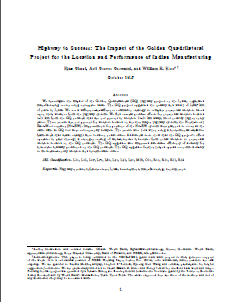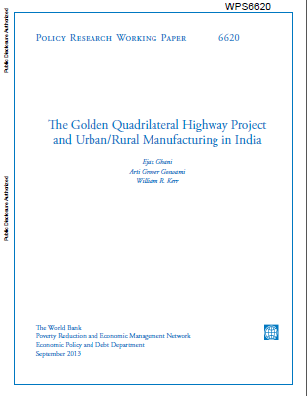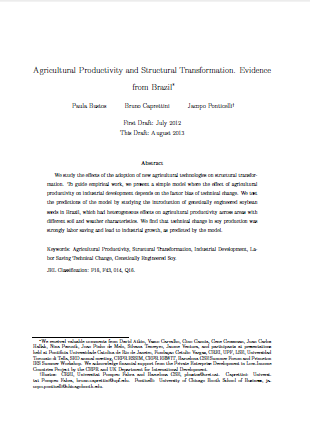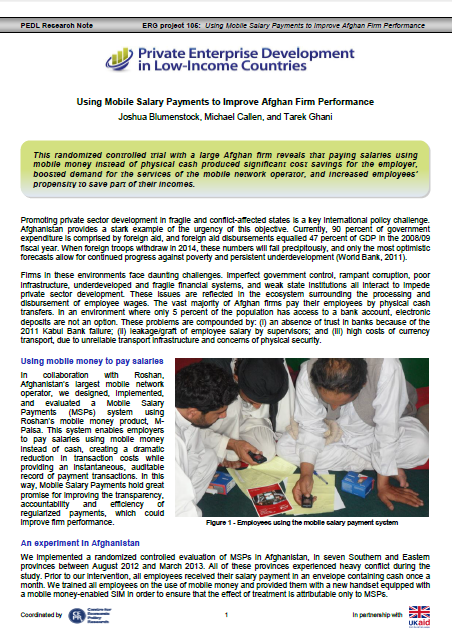WORKING PAPERS

Highway to Success: The Impact of the Golden Quadrilateral Project for the Location and Performance of Indian Manufacturing
Project: Highways, Firm Productivity and Allocative Efficiency in India (2nd Round)
Authors: Ejaz Ghani, Arti Grover Goswami, William R. Kerr
We investigate the impact of the Golden Quadrilateral (GQ) highway project on the Indian organized manufacturing sector using enterprise data. The GQ project upgraded the quality and width of 5,846 km of roads in India. We find several positive effects for non-nodal districts located 0-10 km from GQ that are not present in districts 10-50 km away, most notably higher entry rates and increases in plant productivity. These results are not present for districts located on another major highway system, the North-South East-West corridor (NS-EW). Improvements for portions of the NS-EW system were planned to occur at the same time as GQ but were subsequently delayed. The GQ upgrades further helped spread economic activity to moderate-density districts and intermediate cities.
 The Golden Quadrilateral Highway Project and Urban/Rural Manufacturing in India
The Golden Quadrilateral Highway Project and Urban/Rural Manufacturing in India
Project: Highways, Firm Productivity and Allocative Efficiency in India (2nd Round)
Authors: Ejaz Ghani, Arti Grover Goswami, William R. Kerr
The Golden Quadrilateral project upgraded the quality and width of 5,846 km of roads in India. The study uses a difference-in-difference estimation strategy to compare non-nodal districts based on their distance from the highway system. For the organized portion of the manufacturing sector, the Golden Quadrilateral project led to improvements in both urban and rural areas of non-nodal districts located 0–10 km from the Golden Quadrilateral. These higher entry rates and increases in plant productivity are not present in districts 10–50 km away. The entry effects are stronger in rural areas of districts, but the differences between urban and rural areas are modest relative to the overall effect. The productivity consequences are similar in both locations. The most important difference appears to be the greater activation of urban areas near the nodal cities and rural areas in remote locations along the Golden Quadrilateral network. For the unorganized sector, no material effects are found from the Golden Quadrilateral upgrades in either setting. These findings suggest that in the time frames that we can consider—the first five to seven years during and after upgrades—the economic effects of major highway projects contribute modestly to the migration of the organized sector out of Indian cities, but are unrelated to the increased urbanization of the unorganized sector.
Agricultural Productivity and Structural Transformation. Evidence from Brazil
Project: Agricultural Productivity and Structural Transformation. Evidence from Brazil (1st Round)
Authors: Paula Bustos, Bruno Caprettini, Jacopo Ponticelli
We study the effects of the adoption of new agricultural technologies on structural transformation. To guide empirical work, we present a simple model where the effect of agricultural productivity on industrial development depends on the factor bias of technical change. We test the predictions of the model by studying the introduction of genetically engineered soybean seeds in Brazil, which had heterogeneous effects on agricultural productivity across areas with different soil and weather characteristics. We find that technical change in soy production was strongly labor-saving and lead to industrial growth, as predicted by the model.
Project: Exploring Dynamics in South African firms (3rd Round)
Authors: Andrew Kerr, Martin Wittenberg and Jairo Arrow
Analysts of the South African labour market have predominantly used household surveys to analyse the labour market. It has been more difficult to explore labour demand from the firrm side, as a result of limited data from relatively small cross sectional firm surveys, mainly funded by the World Bank. We use the Quarterly Employment Survey conducted by Statistics South Africa that allows us to explore how South African enterprises create and destroy jobs, shedding light on many of the policy questions that are relevant in a high unemployment society like South Africa. We find job creation and destruction rates are similar to those found in OECD countries. There is little evidence that labour legislation creates rigidities that prevent firms from hiring or firing workers. We also find that larger firms are better net creators of jobs than small firms and that net job creation rates are negative in manufacturing, consistent with work using household surveys. Our research has important policy implications- particularly for the National Planning Commission's suggestion that new jobs will come mainly from small and medium sized firms. Our research suggests this is not likely without changes to policy or legislation.
SME Registration Evidence from a Randomized Controlled Trial in Bangladesh
Project: Exit from Informality: Carrot and Stick (2nd Round)
Authors: Giacomo De Giorgi and Aminur Rahman
Informality is pervasive in developing countries. In Bangladesh, the majority of firms are informal and as such they might not have access to prime markets, while lowering the tax base. The authors implemented an information campaign on registration, including both the step-by-step procedures and the potential benefits from registration. They find that the treatment made firms more aware of the procedures, but had no impact on actual registration. The results point toward potentially low benefits and high indirect costs of registration as the main barriers to formality (e.g. access to markets, taxation, labor and product regulations).
RESEARCH NOTES (PEDL ERG PROJECTS)
Project: Using Mobile Salary Payments to Improve Afghan Firm Performance
Authors: Joshua Blumenstock, Michael Callen, and Tarek Ghani
This randomized controlled trial with a large Afghan firm reveals that paying salaries using mobile money instead of physical cash produced significant cost savings for the employer, boosted demand for the services of the mobile network operator, and increased employees’ propensity to save part of their incomes.



 Research Note #1: Using Mobile Salary Payments to Improve Afghan Firm Performance
Research Note #1: Using Mobile Salary Payments to Improve Afghan Firm Performance
